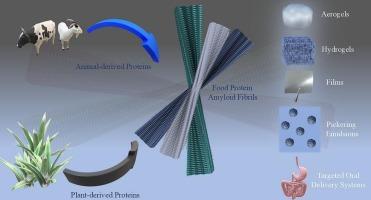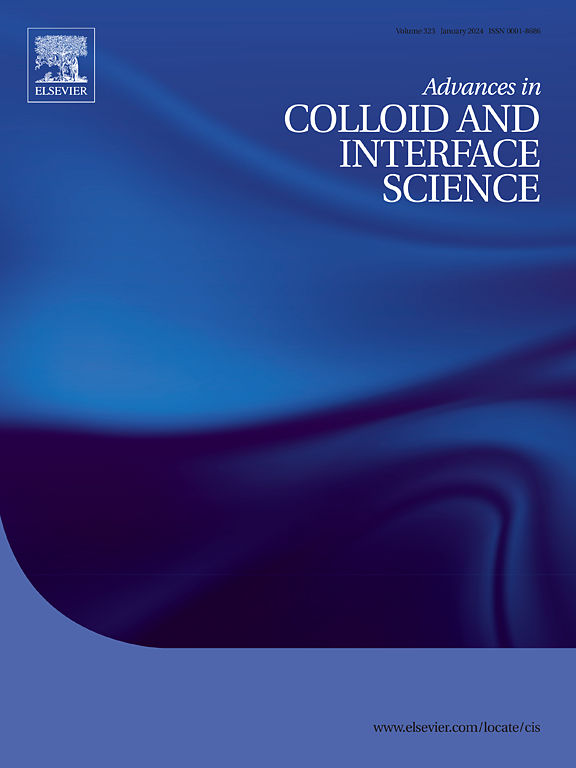Progress and innovations in food protein amyloid fibrils for fabricating cutting-edge soft materials
IF 19.3
1区 化学
Q1 CHEMISTRY, PHYSICAL
引用次数: 0
Abstract
Food protein-based amyloid fibrils (PAFs) represent a novel and sustainable class of functional nanomaterials with growing importance in the design of soft matter systems. Derived from abundant, renewable, and often by-product protein sources, PAFs offer a sustainable/biodegradable alternative to synthetic nanomaterials, combining eco-friendly production with versatile functional applications. Through precise control of environmental factors such as pH, temperature, and ionic strength, diverse food proteins can be transformed into highly ordered fibrillar structures, exhibiting robust mechanical properties, remarkable surface activity, and structural anisotropy. These unique features have positioned PAFs as promising agents for stabilizing emulsions and foams, enhancing the textural properties of hydrogels, and serving as active components in food packaging and biomedical carriers. Their biocompatibility and the presence of modifiable surface groups enable effective encapsulation of bioactive compounds and responsive release under targeted conditions. As research advances, deeper understanding of their formation pathways, physicochemical behaviour, and interaction with other biopolymers will expand their utility across food science, material engineering, and therapeutic delivery systems. This review offers a comprehensive overview of recent insights and emerging strategies in the development and application of PAFs, emphasizing their role in shaping the future of environmentally conscious material innovation.

食品蛋白淀粉样原纤维用于制造尖端软材料的进展和创新
基于食物蛋白的淀粉样原纤维(paf)是一类新型的、可持续的功能纳米材料,在软物质系统的设计中具有越来越重要的意义。paf来源于丰富的、可再生的、通常是副产品的蛋白质来源,它提供了一种可持续/可生物降解的合成纳米材料替代品,将生态友好的生产与多功能的功能应用相结合。通过对pH、温度和离子强度等环境因素的精确控制,多种食物蛋白可以转化为高度有序的纤维状结构,表现出强大的机械性能、显著的表面活性和结构各向异性。这些独特的特性使paf成为稳定乳液和泡沫、增强水凝胶的结构特性以及作为食品包装和生物医学载体的活性成分的有前途的试剂。它们的生物相容性和可修饰的表面基团的存在使得生物活性化合物的有效包封和在靶向条件下的响应释放成为可能。随着研究的进展,对其形成途径、物理化学行为以及与其他生物聚合物相互作用的深入了解将扩大其在食品科学、材料工程和治疗输送系统中的应用。本综述全面概述了paf在发展和应用方面的最新见解和新兴战略,强调了paf在塑造未来环保材料创新中的作用。
本文章由计算机程序翻译,如有差异,请以英文原文为准。
求助全文
约1分钟内获得全文
求助全文
来源期刊
CiteScore
28.50
自引率
2.60%
发文量
175
审稿时长
31 days
期刊介绍:
"Advances in Colloid and Interface Science" is an international journal that focuses on experimental and theoretical developments in interfacial and colloidal phenomena. The journal covers a wide range of disciplines including biology, chemistry, physics, and technology.
The journal accepts review articles on any topic within the scope of colloid and interface science. These articles should provide an in-depth analysis of the subject matter, offering a critical review of the current state of the field. The author's informed opinion on the topic should also be included. The manuscript should compare and contrast ideas found in the reviewed literature and address the limitations of these ideas.
Typically, the articles published in this journal are written by recognized experts in the field.

 求助内容:
求助内容: 应助结果提醒方式:
应助结果提醒方式:


